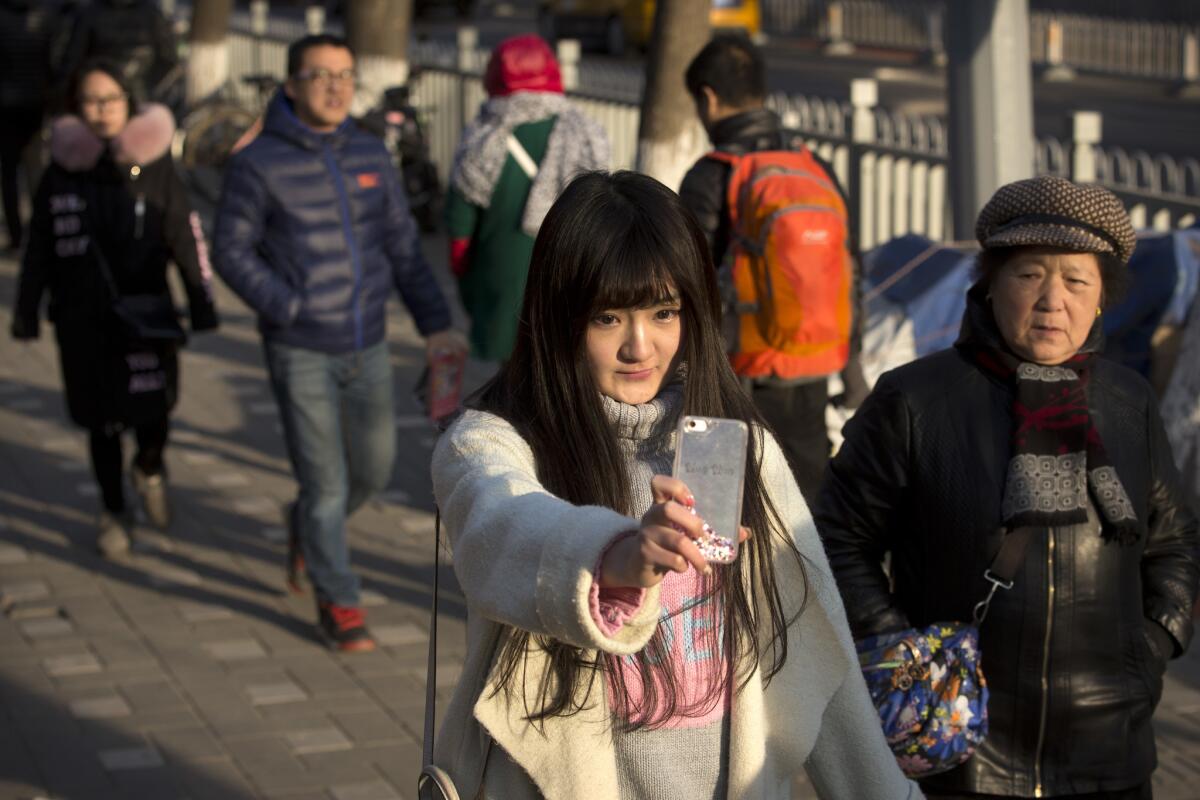In China, live-streaming apps soothe lonely souls and create fortunes

Reporting from Beijing — Cheng Lihua primped her hair, put on makeup and adjusted her gold-plated microphone. Then she got to work.
“You hurt me so deep that I can’t forgive you,” she crooned into the microphone, nodding her head to the rhythm. “Already knew our love is gone.”
Cheng, a 22-year-old recent college graduate, is a professional “live streamer,” a booming business in China these days. She works four hours a day and earns nearly $3,000 a month chatting and singing songs for an online audience of thousands — all from her bedroom in China’s far-northern Inner Mongolia Autonomous Region, where she lives with her parents.
Her income is nearly seven times the average for the region’s new college graduates.
China is home to more than 200 live-streaming platforms, which together constitute a $1.35-billion market, according to iiMedia Research, a Hong Kong-based mobile market research company. Almost half of China’s massive Internet-using population use live-streaming platforms — an estimated 235 million people.
Whereas Americans tend to use live-streaming platforms such as Facebook Live and Periscope to broadcast and watch events, similar platforms in China have emerged as a social-networking tool for millions of lonely hearts who are eager to seek comfort and digital companionship. Live streamers answer questions, offer advice, sing, dance, even eat their meals for all to watch.
In the U.S. and elsewhere, live streaming has emerged as a tool for social activism. At the Standing Rock Sioux Reservation in North Dakota, Native Americans protesting the construction of a pipeline have used Facebook Live to broadcast standoffs with police, a safeguard against brutality. This summer, a Facebook Live user in Minnesota showed the graphic aftermath of a police shooting of an African American man, sparking a wave of protests. People in Ankara, Turkey, have used the platform and Twitter’s Periscope to live-stream a coup attempt.
But in China, where authorities strictly control the Internet, live streaming’s explosive popularity has elicited a raft of new censorship and monitoring regulations.
Authorities have cracked down on live streams involving provocative dancing, coarse language and revealing clothing. Since July, the Ministry of Culture has been conducting random checks on live streams to ensure that any violent or pornographic content is taken down, according to the People’s Daily, a Communist Party mouthpiece.
In May, authorities banned “seductive” banana eating on live-streaming networks; whether one such performance went viral remains unclear.
In November, the Cyberspace Administration of China issued a heightened edict. Under the new regulations, users are prohibited from live-streaming any content that could “harm national security and undermine social stability.”
Chinese Internet firms have shown a willingness to play by the rules. Lei Tao, co-founder of the live-streaming platform Yizhibo, said the company recruited 300 censors to sit in an office in the northwestern city of Xian and check for unlawful content.
“The stricter the regulations are, the more benefits we’ll get,” Lei said. “We are good students in class; of course we welcome the teacher to manage naughty students more tightly. It will be better for the class as a whole.”

Chinese live-streaming platforms use a simple, yet strikingly effective business model.
Viewers open an app and find a stream that fits their interests. Then they can tap out messages to the live streamers. The messages appear at the app’s lower left corner, visible to all viewers. The live streamer can choose to respond.
If the viewer wishes, he or she can purchase a “virtual gift” using real money and send it to the live streamer. This is how live streamers and live-streaming platforms make their money. The cheapest virtual gifts — for example, a flower or cucumber — cost 3 cents on Yinke, China’s biggest mobile live-streaming platform. A more expensive gift such as a virtual yacht can cost about $270. On Yinke, the platform takes 70% of that money, and the live streamer gets the rest.
About two months ago, Zhao Zhenggang, a 22-year-old Chinese citizen living in New York, made about $300 by live-streaming himself talking about life in the city. Then he spent it all on virtual gifts for other live streamers. “It doesn’t matter if the live streamers are girls or boys,” he said. “As long as they are good-looking and talk genuinely, they deserve my money.”
Jin Fengqing, Cheng’s agent — and a recent college graduate himself — oversees more than 500 live streamers. He gives them monthly salaries and pays the platform to promote their streams.
He said 80% of the live streamers in his company are female. In job descriptions, he lists two requirements: having a smartphone and being pretty. “Girls can earn a lot by just being pretty and talkative,” Jin said.
Jin founded his agency, Nanjing Fanlin Media, in March. His only source of revenue is virtual gifts — the agency takes 5%, live streamers 35% and the live-streaming platform Momo 60%. There are about 50 live streamers in his company, and they can earn more than $14,450 a month; they keep in touch with and sometimes even meet their biggest gift-givers.
Jin said he earns more than $100,000 a month.
The stricter the regulations are, the more benefits we’ll get.
— Lei Tao, co-founder of the live-streaming platform Yizhibo
Some Americans in China have been riding the live-streaming wave. Lauren Hallanan, a 28-year-old fluent Chinese speaker from upstate New York, has been live-streaming on the Momo app since February. She uses the app once or twice a day for an hour and a half at a time. Last month, it earned her about $3,770.
Hallanan began live-streaming to promote an online crafts business but quickly found that she could sustain people’s interest just by talking about her life as an American in Beijing. Now, she has 216,000 followers and has added 2,400 every day since September. “It kind of blows my mind,” she said.
“Every day I have viewers asking me, ‘Aren’t all Americans really easy?’ ‘Isn’t the U.S. dangerous?’ ‘Do you just eat McDonald’s and KFC every day?’”
She attributes the popularity of live streaming in China to the country’s zhai nan culture. Zhai nan, a colloquialism meaning “homebody,” refers to young men who spend their lives chained to their home computers, surfing the Internet, playing computer games and chatting online. They’re stereotyped as scruffy, introverted and socially awkward.
“If one has great social skills in real life, one wouldn’t turn to live streaming,” said Yizhibo’s Lei.
Xie Pu, a Beijing-based technology columnist, said many Internet users see live streaming as comforting and economical. For a lonely man, buying drinks at a bar might cost hundreds of yuan, but buying virtual gifts for a live streamer is cheaper and could elicit a much warmer response.
“Watching live streaming is the easiest way to feel soothed after a long day of work,” he said.
But Jin, the agent, is concerned that live streamers will have to adapt quickly to keep up with the times. “A lot of girls cannot do it for a long time, because people will get tired of just looking at pretty faces,” he said. He’s shifting toward more “genuine,” rather than simply pretty, live streamers, as well as dancers and musicians.
Even Cheng is unsure about her future in the industry. Despite her steady income, Cheng said she might stop live streaming once she gets into a relationship.
“I just think it’s not so good to keep in touch with a lot of guys when I have a boyfriend,” she said.
Yang is a special correspondent. Times staff writer Jonathan Kaiman contributed to this report.
ALSO
China hopes new film studio and theme park will boost ties to international movie industry
When marriage counseling fails: Mistress hunters derail affairs with China’s cheating spouses
More to Read
Sign up for Essential California
The most important California stories and recommendations in your inbox every morning.
You may occasionally receive promotional content from the Los Angeles Times.










